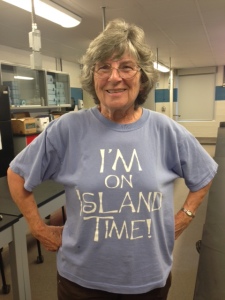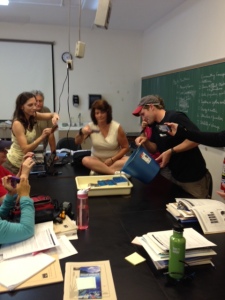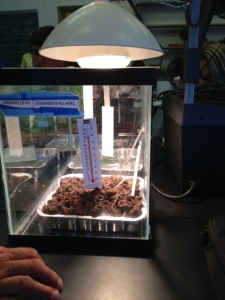Great Lakes Education Workshop
FT Stone Laboratory
Gibralter Island, Lake Erie, Ohio State University
July 21-27, 2013
“I’m Going to Die with My Flippers on…” Dr. Rosanne Fortner
Science and Education Log: With the imminent threat of rain, our first day started on the docks at 8am sharp (no “island time” in this class!) We used equipment ranging from anemometers to thermometers to sling psychrometers gathering weather data for our ‘week long’ data set. It was evident how much technology has advanced as half of the class used hand-held compasses while the other half used smart phone compass apps to determine wind direction. Next, we enjoyed a scavenger hunt and the newly created “Climate Change Expedition”. This gave everyone a chance to explore Gibraltar Island and its unique features. For some of us, this was the first official trip around the island. Once we returned from our outdoor excursions, it was back to the classroom to look at literacy principles and implementation strategies used around the Great Lakes. The class has learned more acronyms in one morning than some of us have learned our whole lives. All of this…before lunch.
The afternoon session started with the class splitting in to three groups. Each group carried out a lesson from the “Climate and Water Movement” ES-EAGLS curriculum guide. Models were built of the five Great Lakes to demonstrate movement and retention of water using a lesson called “Out One Lake and In Another: How long does it take water to flow through the Great Lakes?” The Great Lake watersheds were determined and outlined using the lesson “How does water move in the Great Lakes basin?” After that, the experiments became more involved and data intensive. A dual lesson, “What happens to heat energy reaching the Great Lakes?” and “What causes the land and sea breeze?” enabled us to model land-sea breezes using hydrochloric acid, ammonium hydroxide, and a few common lab materials. Another lesson, “How do the Great Lakes change through the seasons?” involved lake turnover and the density of water throughout the four seasons.
Personal Log: Our class, as a whole, has a broad array of expertise and personal experiences with Great Lakes education. Everyone freely contributes a different perspective to each class topic and offers unique options for utilizing the different lessons in each of our very diverse educational settings. It’s shaping up to be a great week, and it seems like we have so much to learn from each other. As Dr. Fortner put it: “I’m going to die with my flippers on, and even though that will be in a salty environment, it’s up to you people to keep the momentum going up here.” Tomorrow we start our field excursions and get some hands on training in the beautiful Lake Erie island region. Stay tuned!
Tory Gabriel and Kevin Hart




A bunch of acronyms is right, some that I learned about were GLIN, CGLL, COSEE, GLNPO, and GLERL. It is amazing the amount of organizations that are doing work on the Great Lakes.
My students will really enjoy the new “climate change expedition” when we return to the island this October. Will use the lab What happens to heat energy reaching the Great Lakes?
Great Job everyone!
So much fun to see Tory and Kevin teaching on the science cruise on Wednesday. Your presence, demeanor and expertise were so engaging and helpful. I’m sure young students appreciate their time with you both.
That sling psychrometer is pretty slick. I’ve seen many Dr. Fortner led classes using those in the past and had no clue what they were. Accurate too, according to weather.com!